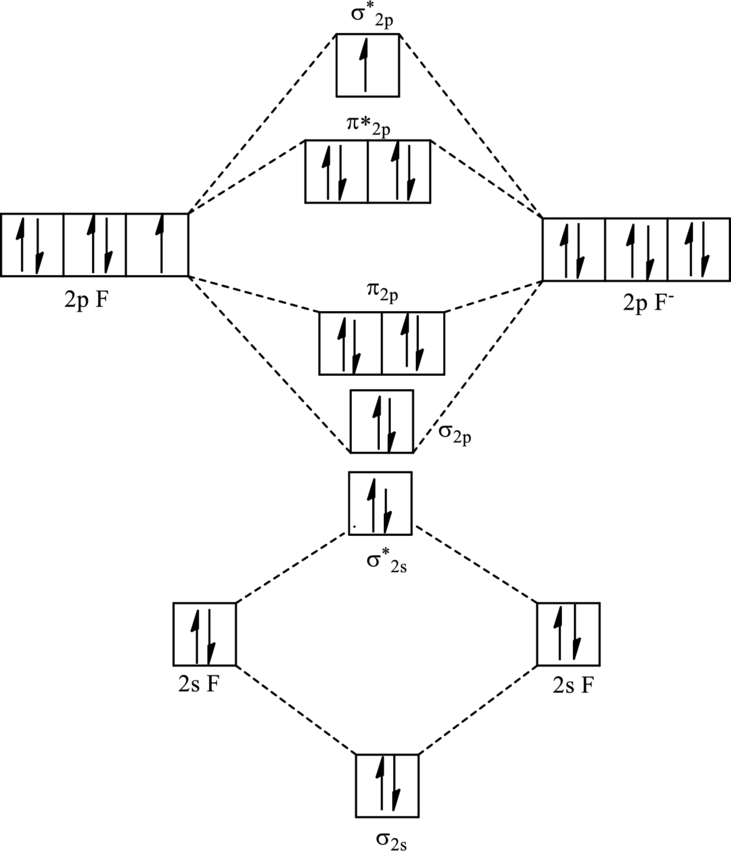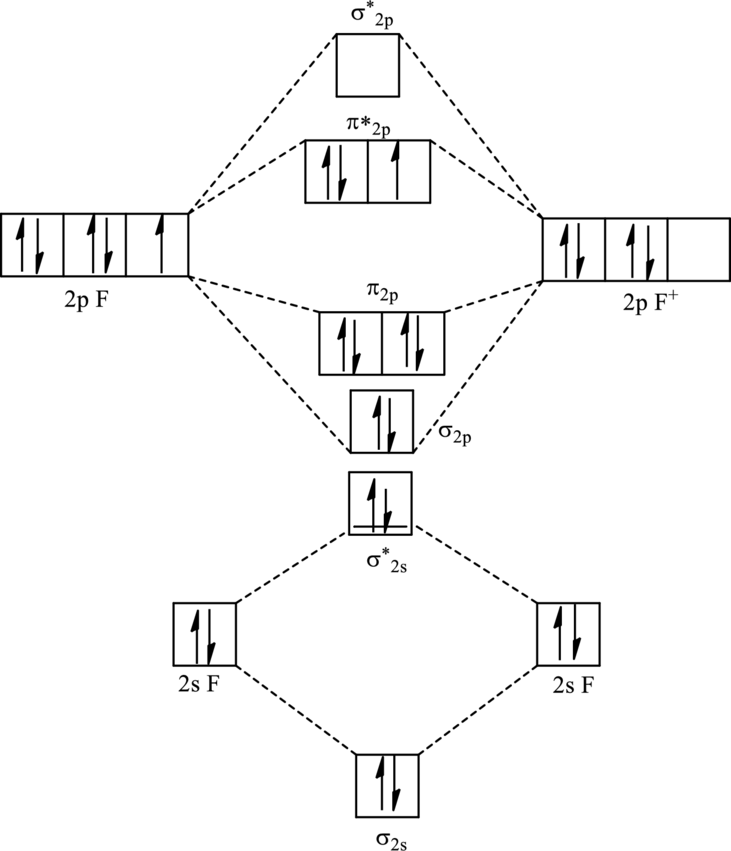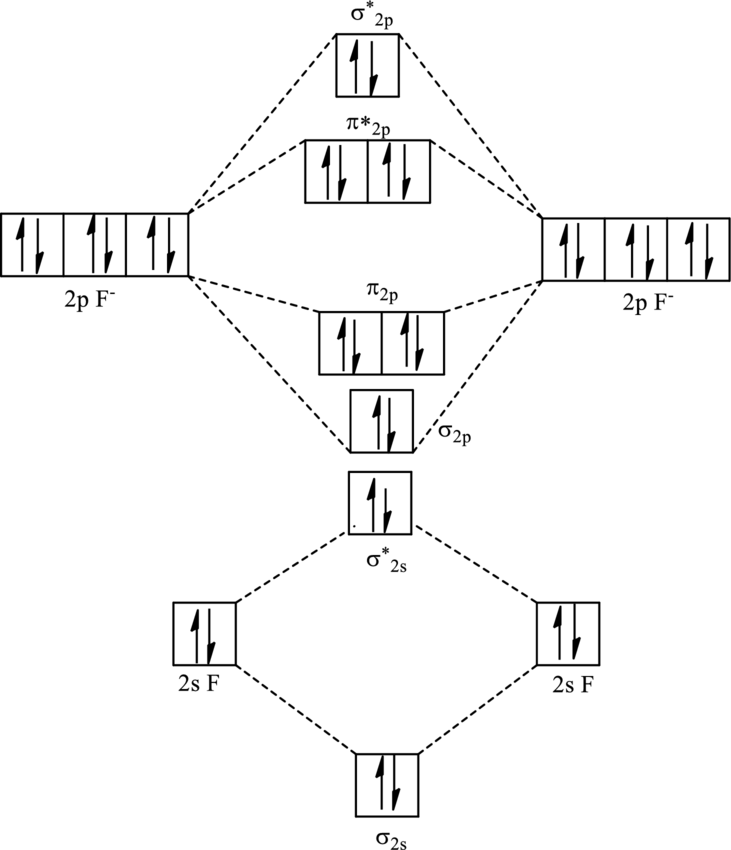
Concept explainers
(a)
Interpretation:
Valence shell electronic configuration of
Concept Introduction:
Molecular orbital diagram is a linear combination of atomic orbitals of similar energy and similar symmetry. It is formed by the proper overlap of the atomic orbitals.
There are 3 types of molecular orbitals as follows:
1. Bonding molecular orbital: They are formed by the constructive interference of atomic orbitals and electrons in it stabilize the molecule and are of lesser in energy.
2. Antibonding molecular orbital: This type of orbitals increases the energy of molecule and destabilizes it and weakens the bond between the atoms.
3. Non-bonding molecular orbital: These types of orbitals have energy similar to atomic orbitals that is addition or removal of electron does not change the energy of molecule.
The order of energy in molecular orbital follows two rules as follows:
1. For
2. For atomic number more than 14 order of energy is,
(a)
Explanation of Solution
For
The symbol for fluorine is
One negative charge is added up in total valence count.
Thus total valence electrons are sum of the valence electrons for each atom in
Hence, 15 electrons are to be arranged in each molecular orbital to obtain an electronic configuration. Since number of electrons in
Hence, the electronic configuration of
For
The symbol for fluorine is
One positive charge is subtracted from the total valence count.
Thus total valence electrons are sum of the valence electrons for each atom in
Hence, 13 electrons are to be arranged in each molecular orbital to obtain an electronic configuration. Since number of electrons in
Hence, the electronic configuration of
For
The symbol for fluorine is
Two negative charges are added up in total valence count.
Thus total valence electrons is sum of the valence electrons for each atom in
Hence, 16 electrons are to be arranged in each molecular orbital to obtain an electronic configuration. Since number of electrons in
Hence, the electronic configuration of
(b)
Interpretation:
Bond order of
Concept Introduction:
Bond order
(b)
Explanation of Solution
The electronic configuration of
Substitute 8 for number of electrons in bonding orbitals and 7 for number of electrons in antibonding orbitals in equation (1) to calculate bond order.
Hence, the bond order of the molecule
The electronic configuration of
Substitute 8 for number of electrons in bonding orbitals and 5 for number of electrons in antibonding orbitals in equation (1) to calculate bond order.
Hence, the bond order of the molecule
The electronic configuration of
Substitute 8 for number of electrons in bonding orbitals and 8 for number of electrons in antibonding orbitals in equation (1) to calculate bond order of
Hence, the bond order of the molecule
(c)
Interpretation:
Molecular orbital diagram of
Concept Introduction:
Refer to part (a)
(c)
Explanation of Solution
For
The electronic configuration of

Since
For
The electronic configuration of

Since
For
The electronic configuration of
The molecular orbital diagram of

Since
(d)
Interpretation:
Character of highest energy orbital of
Concept Introduction:
Refer to part (a)
(d)
Explanation of Solution
For
The electronic configuration of
For
The electronic configuration of
For
The electronic configuration of
Want to see more full solutions like this?
Chapter 2 Solutions
Chemical Principles: The Quest for Insight
- What is the hydronium ion concentration in a solution of water that has a hydroxide ion concentrationof 1.0 x 10-2 M?arrow_forwardIdentify conjugate acid-base pairs in the following reactions:HBr (aq) + H2O (l) ⇌ H3O+ (aq) + Br- (aq) - OH (aq) + CH3COOH (aq) ⇌ H2O (l) + CH3COO- (aq)arrow_forward4:45 PM Tue Apr 1 K 77% Problem 9 of 10 Submit Curved arrows are used to illustrate the flow of electrons. Using the provided starting structure, draw the curved electron-pushing arrows for the following reaction or mechanistic step(s). Be sure to account for all bond-breaking and bond-making steps. Then draw any missing organic intermediates or products for this reaction. Include all lone pairs in the structures. Ignore inorganic byproducts, counterions, and solvents. :0: H Select to Add Arrows HI CH3OH H+ ·HO CH3OH, H+ 0:0 H H Select to Add Arrows tion Versirate CH3OH, H* Select to Draw Productarrow_forward
- Can I please get help with this graph? If you can show exactly where it needs to pass through.arrow_forwardG 1. PPh3, THF 2. 3. LiH, THF ' THF H Harrow_forwardPlease EnCircle or Fill-In your Choice CLEARLY: 21. Please Sketch the intermediates for each step below. Draw the Product which would result from the following series of reactions. Name each Type of Rx: 1. Br2, FeBr3 2. Mg, ether 3. ethylene oxide 4. H₂O+ 5. PBr3 6. Mg, ether 7. 8. H3O+, heat (-H₂O 9. HF ?arrow_forward
- Can I please get help with this question. All required information should be in data table.arrow_forwardesc For the reaction below: 1. Draw all reasonable elimination products to the right of the arrow. 2. In the box below the reaction, redraw any product you expect to be a major product. Major Product: Explanation Check C ☐ + X NaOH Br F1 F2 80 F3 F4 F5 F6 1 ! @ 2 3 $ 4 % 5 Q W LU E S D A F7 * C Click and dr drawing a 2025 McGraw Hill LLC. All Rights Reserv ►II F8 4 F9 6 7 8 9 R T Y U LL F G H Jarrow_forwardCalculate equilibrium concentrations for the following reaction:N2 (g) + O2 (g) ⇋ 2 NO (g) Kc = 0.10 at 2273K initially [N2] = 0.200M; [O2] = 0.200arrow_forward
- For each scenario below, select the color of the solution using the indicator thymol blue during the titration. When you first add indicator to your Na2CO3solution, the solution is basic (pH ~10), and the color is ["", "", "", "", ""] . At the equivalence point for the titration, the moles of added HCl are equal to the moles of Na2CO3. One drop (or less!) past this is called the endpoint. The added HCl begins to titrate the thymol blue indicator itself. At the endpoint, the indicator color is ["", "", "", "", ""] . When you weren't paying attention and added too much HCl (~12 mL extra), the color is ["", "", "", "", ""] . When you really weren't paying attention and reached the second equivalence point of Na2CO3, the color isarrow_forwardThe following reaction is run in which the initial conditions include only methane (CH4) at a concentration of0.115 M. Once equilibrium was established, the concentration of acetylene (C2H2) was measured to be 0.035M. What is the value of the equilibrium constant, K?2 CH4 (g) ⇋ C2H2 (g) + 3 H2 (g)arrow_forwardCalculate the equilibrium concentration of carbon dioxide for the following reaction:2 COF2 (g) ⇋ CF4 (g) + CO2 (g) Kc = 2.00 at 10.00 °C. at equilibrium [COF2] = 0.255M; [CF4] = 0.118Marrow_forward
 Chemistry: Principles and ReactionsChemistryISBN:9781305079373Author:William L. Masterton, Cecile N. HurleyPublisher:Cengage Learning
Chemistry: Principles and ReactionsChemistryISBN:9781305079373Author:William L. Masterton, Cecile N. HurleyPublisher:Cengage Learning Chemistry: Principles and PracticeChemistryISBN:9780534420123Author:Daniel L. Reger, Scott R. Goode, David W. Ball, Edward MercerPublisher:Cengage Learning
Chemistry: Principles and PracticeChemistryISBN:9780534420123Author:Daniel L. Reger, Scott R. Goode, David W. Ball, Edward MercerPublisher:Cengage Learning Chemistry: The Molecular ScienceChemistryISBN:9781285199047Author:John W. Moore, Conrad L. StanitskiPublisher:Cengage Learning
Chemistry: The Molecular ScienceChemistryISBN:9781285199047Author:John W. Moore, Conrad L. StanitskiPublisher:Cengage Learning
 ChemistryChemistryISBN:9781305957404Author:Steven S. Zumdahl, Susan A. Zumdahl, Donald J. DeCostePublisher:Cengage Learning
ChemistryChemistryISBN:9781305957404Author:Steven S. Zumdahl, Susan A. Zumdahl, Donald J. DeCostePublisher:Cengage Learning Chemistry: An Atoms First ApproachChemistryISBN:9781305079243Author:Steven S. Zumdahl, Susan A. ZumdahlPublisher:Cengage Learning
Chemistry: An Atoms First ApproachChemistryISBN:9781305079243Author:Steven S. Zumdahl, Susan A. ZumdahlPublisher:Cengage Learning





